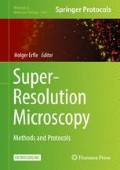Abstract
Multichannel imaging is used as a readout of relative localization of two or more components and is often the first step in investigating functional ensembles in cells. However, the localization volume of diffraction-limited light microscopy (approx. 200 nm by 500 nm) can accommodate hundred of proteins, calling for increased resolution for these types of analyses. Here, we present a protocol for 4-channel imaging using structured illumination microscopy (SIM), which increases resolution by a factor of two. We use adherent, fixed cells to identify the localization of adhesion proteins using immunofluorescence and fluorescent proteins. We discuss how labeling with the necessary brightness is achieved and how data has to be processed for colocalization analysis.
Access this chapter
Tax calculation will be finalised at checkout
Purchases are for personal use only
Abbreviations
- 3D:
-
Three-dimensional
- 3D–SIM:
-
Three-dimensional structured illumination microscopy
- FA:
-
Focal adhesion
- FP:
-
Fluorescent protein
- GFP:
-
Green fluorescent protein
- PALM:
-
Photo activation localization microscopy
- STED:
-
Stimulated emission depletion
- STORM:
-
Stochastic optical reconstruction microscopy
References
Schermelleh L, Heintzmann R, Leonhardt H (2010) A guide to super-resolution fluorescence microscopy. J Cell Biol 190:165–175
Lidke DS, Lidke KA (2012) Advances in high-resolution imaging--techniques for three-dimensional imaging of cellular structures. J Cell Sci 125:2571–2580
Gustafsson MG (2000) Surpassing the lateral resolution limit by a factor of two using structured illumination microscopy. J Microsc 198:82–87
Heintzmann R (2006) Structured illumination methods. In: Pawley JB (ed) Handbook of biological confocal microscopy. Springer, New York, NY, pp 265–277
Gustafsson MG, Shao L, Carlton PM, Wang CJ, Golubovskaya IN, Cande WZ, Agard DA, Sedat JW (2008) Three-dimensional resolution doubling in wide-field fluorescence microscopy by structured illumination. Biophys J 94:4957–4970
Burgert A, Letschert S, Doose S, Sauer M (2015) Artifacts in single-molecule localization microscopy. Histochem Cell Biol 144:123–131
Smeets D, Neumann J, Schermelleh L (2014) Application of three-dimensional structured illumination microscopy in cell biology – pitfalls and practical considerations. In: Fornasiero E, Rizzoli S (eds) Super-resolution microscopy techniques in the neurosciences, neuromethods, vol 86. Springer, New Yor, NY, pp 167–188
Rottner K, Krause M, Gimona M, Small J V, Wehland J (2001) Zyxin is not colocalized with vasodilator-stimulated phosphoprotein (VASP) at lamellipodial tips and exhibits different dynamics to vinculin, paxillin, and VASP in focal adhesions. Mol Biol Cell 12:3103–3113
Hubner B, Cremer T, Neumann J (2013) Correlative microscopy of individual cells: sequential application of microscopic systems with increasing resolution to study the nuclear landscape. Methods Mol Biol 1042:299–336
Chudakov DM, Matz MV, Lukyanov S, Lukyanov KA (2010) Fluorescent proteins and their applications in imaging living cells and tissues. Physiol Rev 90:1103–1163
Cranfill PJ, Sell BR, Baird MA, Allen JR, Lavagnino Z, de Gruiter HM, Kremers GJ, Davidson MW, Ustione A, Piston DW (2016) Quantitative assessment of fluorescent proteins. Nat Methods 13:557–562
Staudt T, Lang MC, Medda R, Engelhardt J, Hell SW (2007) 2,2′-thiodiethanol: a new water soluble mounting medium for high resolution optical microscopy. Microsc Res Tech 70:1–9
Engel U (2014) Structured illumination superresolution imaging of the cytoskeleton. Methods Cell Biol 123:315–333
Case LB, Waterman CM (2015) Integration of actin dynamics and cell adhesion by a three-dimensional, mechanosensitive molecular clutch. Nat Cell Biol 17:955–963
Crawford AW, Beckerle MC (1991) Purification and characterization of zyxin, an 82,000-dalton component of adherens junctions. J Biol Chem 266:5847–5853
Takeichi M (2014) Dynamic contacts: rearranging adherens junctions to drive epithelial remodelling. Nat Rev Mol Cell Biol 15:397–410
Ries J, Kaplan C, Platonova E, Eghlidi H, Ewers H (2012) A simple, versatile method for GFP-based super-resolution microscopy via nanobodies. Nat Methods 9:582–584
Acknowledgments
I am grateful to Tim Mitchison and Matthias Krause for BS-C1 cell and the zyxin plasmid, respectively and Kees van der Oord and Pablo Hernandez Varas at Nikon BV for discussions on 3D-SIM technology. I want to thank all the users of the Nikon Imaging Center at the University of Heidelberg, who helped in improving our SIM routines, especially Diana Rüthnick for testing FPs and reading the manuscript. This work was supported by the CellNetworks Excellence Cluster and the SFB 873.
Author information
Authors and Affiliations
Corresponding author
Editor information
Editors and Affiliations
Rights and permissions
Copyright information
© 2017 Springer Science+Business Media LLC
About this protocol
Cite this protocol
Engel, U. (2017). Four-Channel Super-Resolution Imaging by 3-D Structured Illumination. In: Erfle, H. (eds) Super-Resolution Microscopy. Methods in Molecular Biology, vol 1663. Humana Press, New York, NY. https://doi.org/10.1007/978-1-4939-7265-4_7
Download citation
DOI: https://doi.org/10.1007/978-1-4939-7265-4_7
Publisher Name: Humana Press, New York, NY
Print ISBN: 978-1-4939-7264-7
Online ISBN: 978-1-4939-7265-4
eBook Packages: Springer Protocols

